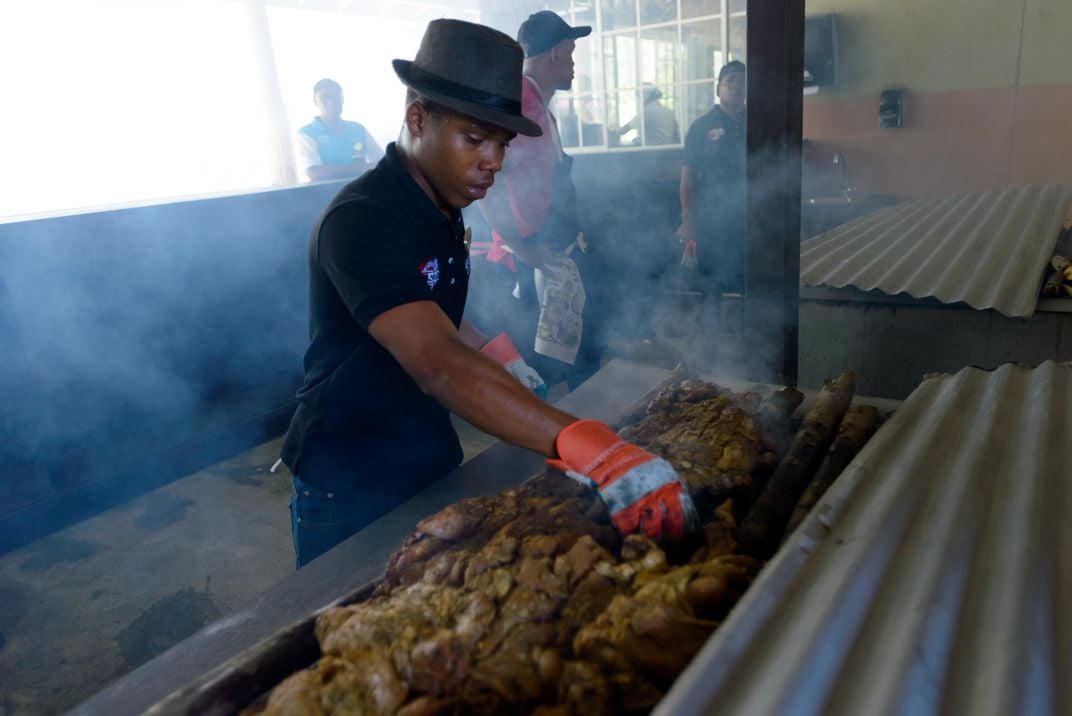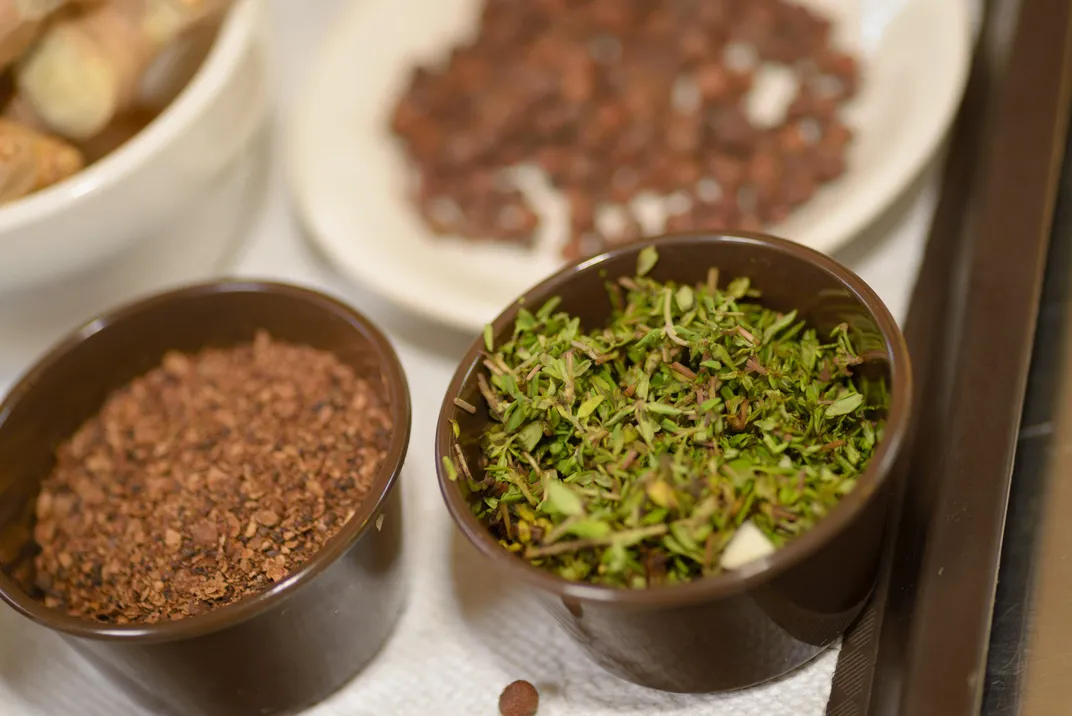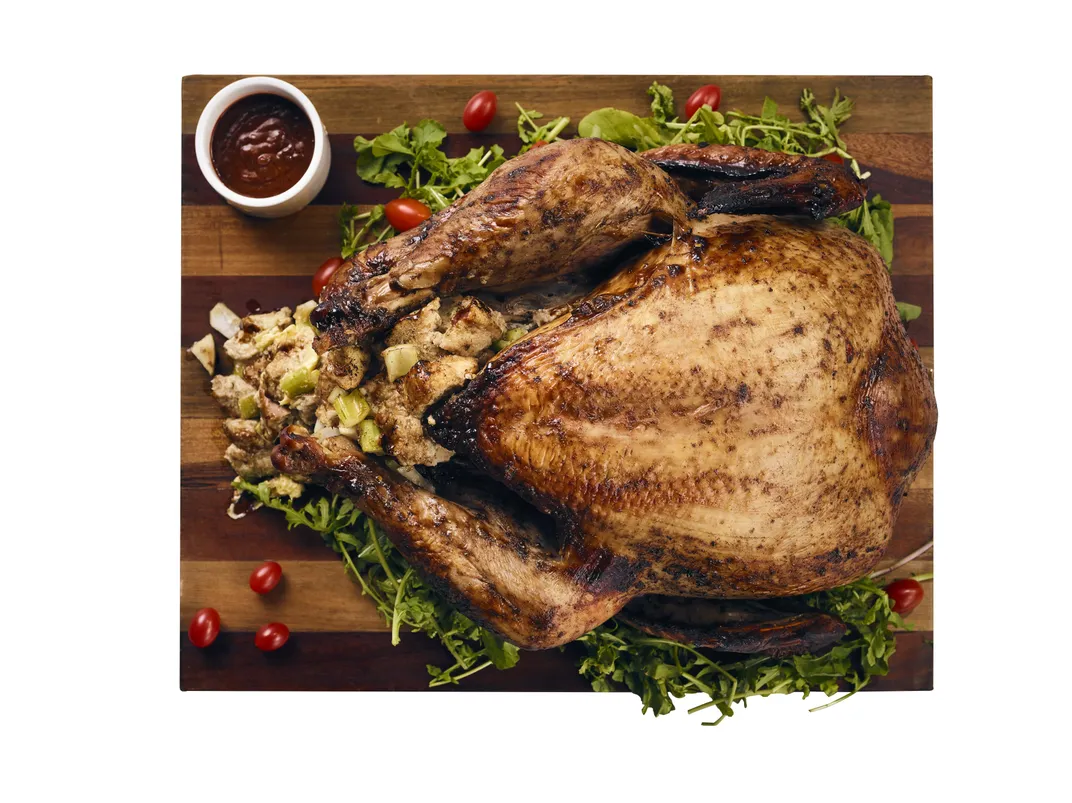A Brief History of Jamaican Jerk
It’s more than just a seasoning or a flavor. Jerk is a whole culture worthy of celebrating, especially at Christmastime
/https://tf-cmsv2-smithsonianmag-media.s3.amazonaws.com/filer/49/1b/491bbe86-4b78-4d09-a4e3-4cc2dbe1d33d/if_making_jerk_seasoning_from_scratch_is_too_much_to_put_on_your_plate_many_us_grocery_stores_carry_marinades_and_seasonings_from_jamaican_companies_like_grace1.jpg)
Last month, McDonald’s franchises in the United Kingdom launched a jerk chicken sandwich as part of its 2020 festive menu. Though the fast food company clearly hoped to capitalize on jerk’s significance to Jamaican diaspora, especially at Christmastime, this dish certainly wasn’t made for the nation’s 800,000 Jamaicans.
In the same way that Jamaicans across the world digitally joined forces in 2018 to address Jamie Oliver’s ignominious Punchy Jerk Rice, they refused to let this culinary insult pass. The otherwise well-regarded plucky British chef unveiled a new microwave-able ready-to-serve package of flavored rice with garlic, ginger and hot peppers; the result was far from anything resembling what Jamaicans knew as “jerk.” Their disdain was shared through Twitter rants, op-eds and appearances on morning television. The British newspaper the Sun referred to the outraged diaspora as “snowflakes,” and numerous white people on social media lamented that jerk was “just a sandwich.” But the fact is, for Jamaicans, jerk is much more than “just” anything.
As Carolyn Cooper, notable Jamaican literary scholar, explains, jerk is “one of the enduring legacies of the fusion of African and Taíno cultures in Jamaica.” The Taíno, an Arawak people, were members of the Caribbean’s Indigenous population. They were the first to call the island Xaymaca, meaning “land of wood and water,” and first came into contact with Europeans when Columbus arrived in 1494. Spanish colonialists formally arrived 15 years later, but their settlement was small and relatively under-funded compared to other Caribbean colonies. The Spanish did however bring enslaved labor to the island, which served mostly as a trading post
War between England and Spain reached the shores of Jamaica in the middle of the 17th century, leading to a British invasion and the Spanish abandoned the island for their more established settlement in Cuba. Those who had been enslaved fled to the island’s mountains and became known as the Maroons—derived from the Spanish word cimarrones, meaning mountaineers. But by the time the Maroons encountered the island’s original inhabitants, who had also sheltered in the difficult-to-traverse ranges, 90 percent of the Taíno population had become extinct. The British, meanwhile, rapidly expanded their presence on Jamaica, shipping enslaved labor from Africa that would become the engine of the booming sugar industry. Over the years, the Maroons would grow in population as enslaved people would escape the plantations for the mountains.
Adds Cooper, “Archaeological evidence shows that Maroons who disdained enslavement and claimed freedom in the island’s mountainous interior settled among the Indigenous people who survived the trauma of ‘discovery.’ They shared culinary traditions.” Among those traditions was jerk.
Jerk, as a stand-alone term, refers to the way in which meat is seasoned, smoked and grilled. Whereas a historical jerk seasoning recipe calls for bird peppers, pimento and pepper elder, modern recipes may include Scotch bonnet peppers, scallions, garlic, ginger, pimento, thyme and cinnamon. Like barbecue from the American South, jerk today is a remnant from the era of slavery, when Maroons would transform tough cuts of meat into tender, delicious dishes. According to Gariel Ferguson, an acclaimed chef and restaurateur who participated in the inaugural edition of the James Beard Foundation’s “Savoring Jamaica” celebration, escapees traditionally hunted wild boar; seasoned the meat with pimento (allspice berries), salt and bird peppers (a species of chillies in the same family as cayenne); wrapped it in pepper elder leaves; and finally cooked it in “an underground smokeless pit … roasted over dying embers.”

The smokeless pit’s significance stems from the fact that the Maroons, who sought refuge in Cockpit Country—the mountain range surrounding the plantations where they’d previously been enslaved—had to sustain themselves without revealing their locations. If they cooked over an open fire, the smoke would betray them.
“The Maroons developed alliances with Indigenous inhabitants who taught them to preserve meats with available spices and leaves and developed an underground cooking method to evade their enemies,” says Ferguson. “The contribution of the preservation of meat underscores the gift of strategy and planning.”
To feed themselves in the face of adversity, the Maroons had to hunt, prepare, preserve, transport, nourish and sustain while always on the move—often for decades. Ferguson puts it best: “Jerk is freedom manifested in food.”
Jerk today has developed from portable, shelf-stable sustenance like beef jerky into a culinary mainstay. It, too, has gone from a celebratory meal to a part of everyday dining. Jerk is on the menus of school cafeterias and office canteens. Throughout the island, "jerk centers" (restaurants dedicated to jerk cuisine), jerk pan men (male chefs who operate roadside jerk stands using converted metal oil drums as smokers/grills), and women-operated cookshops that have jerk Fridays, are prolific.
Wherever Jamaicans settle, they bring jerk with them—some end up opening Jamaican restaurants. The major Jamaican diaspora communities of New York City, Toronto, London and Miami have always had vibrant Jamaican and Caribbean restaurants. Jamaican patties are even served in the cafeterias of some Toronto school districts. But in the last decade, corporations have seemingly jumped on the "Brand Jamaica" train, with ill-fated concepts like Jamie Oliver’s rice packet.
Jamaicans don’t necessarily have a problem with others showing affection for our culture. After all, we let the American cast of Cool Runnings get away with their terrible Jamaican accents. But we do take issue with whitewashing a significant part of our culture and marketing it as authentic. If global brands simply called their items “Jamaican-style,” “Caribbean-style” or “our take on Jamaican jerk,” rather than just jerk, much of the controversy over the past few years could have been avoided.
“They are so focused on the cachet of jerk as a name that they end up missing the real prize of delivering its awesome, authentic flavor,” says Ferguson. Cooper echoes this sentiment, noting, “Products like Campbell’s ... Jammin’ Jerk Chicken With Rice and Beans soup are likely to be greeted with derision by Jamaicans who know that authentic jerk food cannot be easily packaged for mass consumption. [They are] often watered down... losing the pungency of the pimento berries and Scotch bonnet pepper that are essential ingredients of the fiery seasoning.”

Craig Wong, a Michelin-trained Jamaican Chinese chef who owns the popular Toronto restaurant Patois (named after one of the languages spoken in Jamaica) and who recently opened Dubai’s first Jamaican restaurant, Ting Irie, says he loves seeing the public’s increasing receptiveness to Jamaican cuisine. But he’s clear about where he stands regarding its appropriation. “The way I approach exploring new cuisines is to delve not only into the dish for inspiration, but [also] research the foodways and listen to the authorities of that cuisine,” Wong explains. “Learn the what and why about the culture before you borrow from it, and show respect by being as accurate as possible.”
As Cooper says, jerk seasoning, “like reggae music, … has become a global Jamaican brand.” Every year, Grace Foods, the island’s largest manufacturer and exporter of Jamaican food products, sells close to three million jars of jerk seasoning (paste) globally.
According to Jamaica’s official culinary authorities, for a dish to be classified as “authentic jerk,” the meat has to be smoked over pimento wood. Luckily, a handful of online sellers with ties to the island ship pimento wood chips to the United States, meaning you can easily bring a taste of Jamaica to your table this holiday season.
Jerk (especially chicken) is a part of Jamaican Christmas dinner along with curried goat, roast beef, ham, oxtails, and Jamaican Christmas cake (a version of English plum pudding). Two types of jerk seasoning—power and paste—are available commercially in mild and spicy varieties. Jerk paste acts as a marinade, allowing the flavors, which intensify during smoking, to penetrate the meat right to the bone. Take warning: If you have an aversion to spice, even the mild flavor will make you experience a burning sensation that lingers. (I prefer the mild.)
“Celebratory dishes should be flavor bombs, and jerk is about as deep and fragrant as it gets,” says Wong. Though not traditionally transformed into jerk (chicken, sausage and pork are most common on the island), turkey and ham are great ways to explore Jamaica’s flavors over the holidays.
**********
To make jerk, you’ll need approximately two to three tablespoons of seasoning paste per pound of meat. Massage the seasoning into the meat and let it rest overnight. Then, smoke it, ideally in a smoker. If you don’t own one, here’s how to convert your oven into a makeshift smoker:
- Line a cast-iron skillet or metal baking tray that’s at least an inch deep with aluminum foil.
- Cover with pimento wood chips and light on fire.
- Once the flames die down, place the tray or skillet on the bottom rack of a preheated oven under the turkey or ham.
A 12-pound turkey will take around six-and-a-half hours in a traditional smoker set at 240 degrees Fahrenheit. A leg of ham, meanwhile, requires approximately one-and-a-half hours per pound at 225 degrees.
Many grocery store chains across the U.S. carry ready-to-use jerk seasoning paste from manufacturers like Grace. But if you're up to the task of making a homemade version, here’s a Jamaican-approved recipe.

Jamaican jerk marinade
Ingredients
6 medium-sized Scotch bonnet peppers (can substitute with habaneros but not jalapeños)
1 yellow onion
1/2 cup chopped scallions
6 cloves of garlic
1/8 cup white vinegar
1/8 cup fresh lime juice
2 tablespoons oil (olive, vegetable, or canola)
3 tablespoons chopped ginger
2 tablespoons brown sugar
2 teaspoons salt (omit if using on ham)
1 tablespoon cracked black pepper
1 tablespoon pimento berries (or 1½ teaspoons allspice)
1 teaspoon nutmeg
1 teaspoon cinnamon
1 sprig of fresh thyme
Method
Place ingredients in a blender and pulse until the mixture turns into a smooth paste. The marinade can last up to six months in the refrigerator.
The Jamaican axiom of “ten stories in one” encapsulates jerk. The dish represents both a fascinating facet of food anthropology and a link to our ancestors. Jerk reflects these individuals’ ingenuity and ability to develop flavors from a collection of hunted and foraged ingredients. The Jamaican diaspora—fueled by a national pledge that dictates Jamaicans should play their part in “advancing the welfare of the whole human race”—will fiercely protect both its history and authenticity.